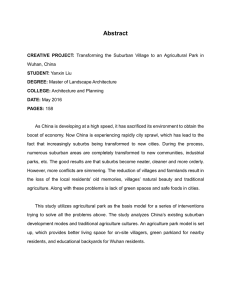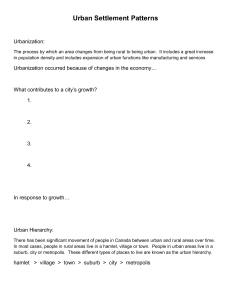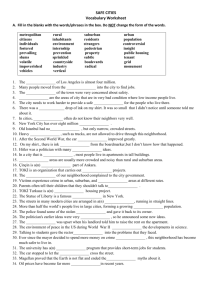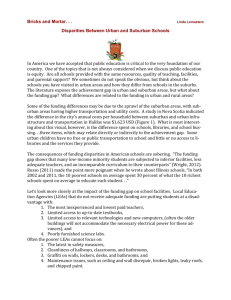by (1968) (1967)
advertisement
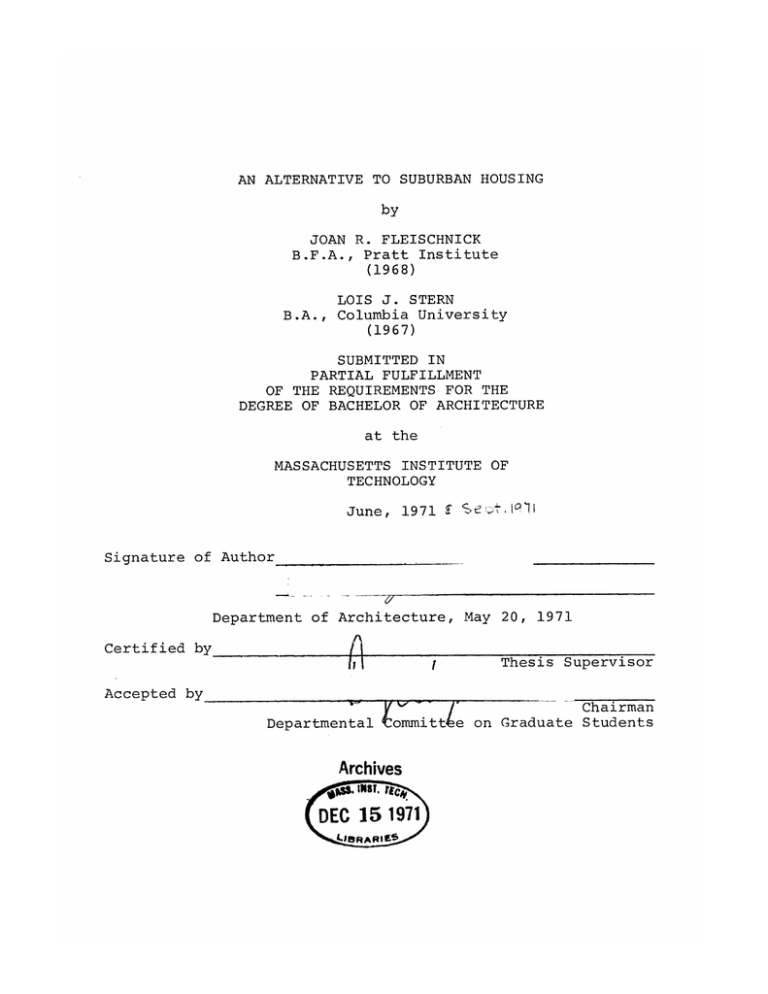
AN ALTERNATIVE TO SUBURBAN HOUSING by JOAN R. FLEISCHNICK Institute B.F.A., Pratt (1968) B.A., LOIS J. STERN Columbia University (1967) SUBMITTED IN PARTIAL FULFILLMENT OF THE REQUIREMENTS FOR THE DEGREE OF BACHELOR OF ARCHITECTURE at the MASSACHUSETTS INSTITUTE OF TECHNOLOGY 1971 June, - Signature of Author Department of Architecture, May 20, 1971 Certified by Thesis Supervisor Accepted by Chairman Departmental ommitt e on Graduate Students Archives (DEC 15 1971) 06R A RI ) ABSTRACT An Alternative To Suburban Housing Joan R. Fleischnick Lois J. Stern Submitted to the School of Architecture and Planning on May 20, 1971 in partial fulfillment of the requirements for the degree of Bachelor of Architecture. This thesis presents a design for a suburban, middleclass housing development on a specific, sixty-acre site in Northboro, Massachusetts. wanted the design to The present owner of the site preserve the land, to the greatest extent possible, in its natural, thickly wooded condition. To achieve this goal, the housing had to be clustered. This clustering represents a major departure from typical suburban development. Part of the problem, therefore, was to reconcile the client's wish to preserve the land with the tastes and needs of typical suburban residents, who are accustomed to detached, one-family houses. This concern for the tastes of typical suburban dwellers also guided the rest of the design, particularly We studied the housing that is now being the interiors. built in the suburbs, we interviewed suburbanites, we examined the house and garden magazines - all to learn as best we could what suburbanites actually want. Our design therefore includes some features of standard suburban construction. But we think that the greater variety and flexibility of our design may make it superior to conventional development in satisfying people's needs. Thesis Supervisor: Robert Goodman Title: Assistant Professor of Architecture Thesis Supervisor: Jan Wampler Title: Assistant Professor of Architecture 1 The Problem of Suburban Housing In General Perhaps the central issue in the design of suburban housing is that of choice. nificant choices in People really don't have sig- housing types in suburbia. This can in part be attributed to restrictive zoning practices, but is also due to the manner by which suburban developments are planned, designed and built. Consumers, the housebuyers, are forced to accept the builder's product. Options are mostly decorative and image making--the double door, the number of standard fireplaces, the kitchen cabinets. Even the choice of image itself is limited to a sort of reduced mansion--columns, paned windows, railings, symbolic grounds. The interior image has remained essentially the same with the now standard addition of the fourth bedroom, family room, and multi-car garage. This lack of development of the interior space is particularly significant in a climate in which people spend nine out of twelve months of the year indoors. choices in interior planning. There are few These choices are almost exclusively limited to decoration and convenience items at the level of electricity vs. gas in the kitchen. Large homes are designed for the young family, but cannot easily adapt to changes in family size or living patterns. Interior walls and dimensions often severely restrict the placement of furniture so that identical 2 furniture arrangements from house to house are inevitable. This situation is hardly optimal. Families we spoke with placed a great deal of attention on the interior of the house and really did appreciate our efforts at spatial choices and participation in making those choices. For example, a doctors' wife found a large formal dining room a necessity, while a truck driver's wife wanted a smaller purely functional dining area, but wanted space for a formal living room. Some apparent luxuries are actually becoming minimum standards. The typical suburban buyer wants no fewer than four bedrooms. Kitchens and bathrooms, their number and their conveniences, are important selling points and images. Double sinks, refrigerators, customized fixtures and finishes produce increases in house value greater than their cost. Suburban homes are territories surrounded by well delineated lot lines which are often walls of some sort whether they be man made fences or trees and shrubs. People define their territories and like to have visual markers of where their territory is. The problem of providing consumers with real choices extends beyond the living units themselves. Suburban houses usually come on predetermined lots, bulldozed and simplified according to zoning regulations and builder's profit motives. People are then forced to landscape and care for their property, particularly the lawn, in a 3 uniform way. In much of suburbia, care for the ground has been taken over by the professional gardener. The same is often true for snow removal and window washing. Professionals are taking over responsibilities that the family once shared. Some families have no desire to look after the exterior of their homes. There is little or no escape from the chore of maintaining the close cropped lawn. At present, there is suburbia to live in little if any opportunity in a natural setting with the ground as undisturbed as possible. With the exception of government owned parks, people do not presently have the availability of a multiacreage landscape where they would have the opportunity to grow things alone or communally, where they might enjoy camping, fishing, or just being in the natural landscape close to where they live. The automobile is an absolute necessity in suburbia. It is generally housed in covered parking spaces. Care for the car has been largely taken over by the garage and the car wash. In summary, maintenance is one of the greatest problems in suburbia and with homeownership in general. Out of it grow endless varieties of conveniences and gadgets--the snowblower, the selfcleaning oven, the electrified roof and driveway to melt snow, the burnerless stove, the no frost refrigerator, the automatic sprinkler and dozens 4 more. More and more homeowners are turning to professionals for home maintenance. Many people would like not to have to deal with maintenance problems at all. Detached homes on separate lots therefore have important disadvantages. For this reason we wanted to design suburban housing that would contain the "standard" amenities of present suburban housing, but with the units clustered. Our site is a particularly appropriate one on which to design clustered housing, because the land is extraordinarily attractive, and the client wants it preserved. So, on the one hand, we have accepted certain features of present suburban development, such as four-bedroom units and lavish appliances, and we have even tried to provide for more complete satisfaction of such needs by increasing the variety and flexibility of the interior design. But, on the other hand, we are also seeking a workable alternative to the detached house on its separate lot. The Specific Problem Our site is approximately 60 acres in Northboro, Mass. near the intersection of routes 1-290 and 495. the fastest growing residential area in This is Massachusetts. The land was about to be sold to a developer who wanted to divide it into uniform lots for standard suburban development, when instead, the present owner obtained it. His hope is to make it an example of how suburban development might 5 take place along sound ecological lines, preserving the greater part of the site for farming or recreation. land is suited to a wide range of uses. The It varies from high, heavily wooded land with hardwoods and fir to lowland marshes and meadows. Ledge, covered with forestation rises over 100 feet and contains a waterfall leading to a small lake below. ago. The land was last forested about 100 years The site is surrounded by other property whose future use is unknown at present. The client is extremely concerned about the development of the land. He would like to offer it for people to live on in such a way that the landscape could become a natural surround for a contained development. To accomplish this he is prepared to expect a substantial decrease in overall density. For him each tree is invaluable. The client contacted M.I.T. for help in developing ideas. He was careful to allow us great freedom in program and design so that the learning process between us could in fact be two-way. Our Approach Siting We consider the top of the ridge at its eastern end most suited to housing. Soil conditions are consistent here and much of the remainder of the site is marshy. A dirt road 6 has already been cut through to the top of the ledge simplifying the problem of access. The view at this point is broad, and southern sun penetrates the high trees. The housing can maintain a sense of privacy from the road and the future possibility of adjacent suburban development. Meadows and lowlands can be used for small gardens or for larger scale vegetable gardening (see site plan). Remaining parts of the site provide places to camp, horseback ride, fish, bike, walk, etc. An overall density of about 1 unit/acre would insure the preservation of open land the client intends. The most pleasant place to be on the site is the ledge at the point at which it overlooks the small lake. From this point one can survey the major part of the lowland as well as be close to the waterfall and stream. themselves toward this view. All units orient Here housing is sited around a large area of undisturbed woods which continues in and around the housing clusters. Between the clusters, a hard packed surface with thinner vegetation allows access for large vehicles such as fire trucks, moving vans and ambulances. Normal vehicular access is contained on the northern side of the site with direct entry to covered parking under the larger units. Pedestrian paths connect all major points of cir- culation and provide safe places to stroll both within the developed area and without to the lake and far end of the meadow and wood. 7 Housing Types There are two basic unit types which reflect the two basic The units on the flatter land are site configurations. duplexes which stagger in plan and which step up in section to a maximum of three units (6stories) at the point of entry to the larger housing group. As the building steps down, roofs of adjoining units act as common terraces. The buildings then themselves provide open space for small roof gardens, for children's play and for places to meet neighbors. The duplex units themselves also step back in section opening the living and kitchen areas onto decks which are oriented to the primary view. Units on the ground have their own small gardens which are defined in part by walls of adjacent units and which can vary according to individual preference. There is access from these gardens to the southern living spaces. Entrances are along covered pedestrian paths on the north. The second housing type is the individual rowhouse which steps down the ledge and out southward toward the landscape. These units also provide several exterior private terraces as well as access to the roof for use as a deck or to allow for the option of expansion. Inside spaces in conjunction with terraces extend themselves to the landscape and view. Each house has its own private entrance garden on the north which may be fenced off from the public space. 8 Housing Criteria Certain issues were critical in the planning of all units beyond the site deoisions discussed above. Interiors should be flexible so that living spaces are not doomed to singular use. Both those families who are accustomed to conventional housing and those who might want to experiment withspaces should be able to identify with and enjoy these homes. The kitchen/living space concept allows a broad range of informal to formal life styles. Bedrooms, too, are designed as living spaces. Interior walls can be removed in planned ways to form larger living spaces. As a family grows, people change and, therefore, spaces should change (and/or people should change spaces). Simple changes can achieve this flexi- bility throughout the design. Kitchens and bathrooms play an important role in providing convenience, saleability and image. The importance of these and other conveniences and gadgets must be understood and reflected in the design. Circulation can be more than just a staircase. It can allow one to move through the units and to experience various relationships of spaces. It can bring spaces together by producing movement between them, or by openning them up visually to one another. The circulation patterns and spaces should enable one to understand where he is in relation to the larger space both in the interior and with the site. It should not interfere, however, 9 with basic functions of various spaces. Non-Professional Output It is important to talk to others who might be potential users of such an environment as part of the design process. There was some attempt to do this. Units should be represented in as comprehensible forms as possible. To facilitate this process, -people liked to look at floor plans as a result of their experience with magazines and other media. Brochures on new developments usually show prospective buyers floorplans of the basic units. Conclusion This design exploration represents a first stage in a solution to this problem. Further study should include market research in conjunction with design experiments into housing size, mix, options, costs and financial and political alternatives. We would wish to explore the possibility of more diversity in design, without sacrificing the identity of the whole. For us, this problem was the most complex in scope, closest to our own personal experience suburbia), (having lived in and one of the most significant in today's housing market. The design of housing for those who can afford housing should be more than just a "pink box". Work Procedure The joint thesis is a useful and productive experience. At each stage in the development of the design there is a sounding board and another viewpoint. Criticism and 10 evaluation become intrinsic to the design process. It is important to be able to develop the skill of working with other people while still within the school. facilitates the sharing of references -buildings, work experience, people -- Working together books, various which is significantly more difficult when design work is done in an isolated way. Most important, however, is the development of an ability to evaluate one's own work and attitudes as well as those of the other person. 11 THE SITE p. 13 Map showing relation of Northboro in general metropolitan area p. 14 Contour map of Northboro site and surrounding property (60 acres) p. 15 Strawberry patch p. 16 Dirt road p. 17 Detail of Rock Formation p. 18 Stream on upper ledge p. 19 Detail of stream p. 20 Waterfall p. 21 Lake view from ledge p. 22 View toward Maynard Road p. 23 View from bottom of waterfall p. 24 View of waterfall and ledge from Maynard Road p. 25 Lower meadow p. 26 View of ledge and shelf formation 12 .- omSalem,- A ~ ~~~ ~ 'Will.w.WNI 3~~~V ~ -dill.M.. 3 4 I4. IIV .P,- otly1.9 oft it I....iproth Bbtr .L MII er Xlve Bo~> 7.-J.- m i~r~'7 4~'~ ~j773 ~"''~ I ~ 71~- 7 ..... Nepot"tV .- - N - i-J -. tm7+Au*~;% :.j- l -Zr 6'11 4ive3 3.,000 ' G 0 I- r it / p I" ~IIJ I i~ v~I. g r~' V\ i \ Wi 1'~ kiI, '~i WI6 4I 4 '. A- %2L - Amp -o* -ll Ib ? 4' I TAt 4>I11 S II '"V IS '7/ 4 It A 'K V 40 I V ! z y 2-1 * - ~4Ja A -~ ,~f ~L. 1?' I -p -4 p.. U. 'I AMM- 11 -L Au An - ~1^ 4 26 L i a look at suburbia 27 N. L '31 I .uwo pb00 Aria U- A. N N F -g 30 RIC7 ~-: AM F F1 iti IOl F' 31 'A I I .i9 v T Al ) "N-l. I * (j 1~N I I 77 - eW A. Fl I 'U ii W H- \1 DESIGN Contour Model of Site p. 38 Overall view p. View looking north 39 p. 40 View of ledge showing location for future housing Site Plan p. 41 Overall site plan showing 60 units of multilevel and single-family dwellings p. 42 Site plan showing pedestrian and vehicular circulation, private exterior gardens, and public spaces Contour Model Showing Housing Clusters p. 43 Southeast view p. 44 View showing relationship of clusters p. 45 View showing both housing types (left, single-family rowhousing clusters/right, multi-family duplex dwellings) and pedestrian path p. 46 Terraced multi-family dwellings p. 47 Single.family dwellings on the ledge Housing Types A. Duplex p. 48 Prototypical Plan p. 49 Alternative 1 First level platform and steps extend into dining/ work space. Major living room is separate from dining. Second level bedrooms extend into one another. p. Alternative 2 based on an interview with a suburban housewife 50 35 Notes on an interview with Mrs. Lacy House, entry: Chandelier, dainty seat, mirror, double door. Kitchen: Low refrigerators, brick built-in oven, expensive linoleum, broom closet, counterspace, dishwasher Den: walls panelled, picture window ceiling to part way down, stereo unit, bookcase, louvre doors on closet, rug with bright circular'raised pattern, two chairs, each 2 ]/2 ft., lamp in center, couch and table, wall-to-wall fibreglass drapes, stack tables, planters, magazine rack Dining room: Enlarge, chandelier, wall-to-wall orchid rug, sliding doors, prints, sliding door between kitchen and dining Living room: Stacked table, windows with squares, man's chair with hassock, coffee table, lady's chair and coffee table, flagstone patio, wrought iron plants furniture, glass tops in bright colors, Sandy's room: wall-to-wall rug, double bed, louvre door closet, drawers in closet Gary's room: Two beds, dresser, desk chair and T.V. Master bedroom: Sliding doors, white and white drapes love with sheers and tassels, blue and orchid prints, convert dressing seat, two dressers--2ft. and 6ft., room into walk-in closet Tile floor, tile on bathroom floor as Laundry room: well, all white, his and hers sinks 36 p. 51 Sectional perspective B. Rowhouse p. 52 Prototypical Plan p. 53 Alternative 1 based on interview with a Doctor's wife. Living spaces provide the opportunity for traditional furnishings. Flexibility can easily be achieved. (example: on upper level extra bedroom becomes study for master suite.) p. 54 Sectional perspective C. p. 55 Section through site 37 SC51 4 -,,1 ,O17 -i 0 t -A- 4 -I -N I (j S V? %o TW-j i 'K 'A ~.1.1I it V A v 66 Ix. 4f -~ I I i 4 U' A I 1 e ~ / 4 LEVFi.L LP-VEL- ?. LEVEL I LE v- 7_ I Lavet. I I _0< 7 j4~ //4/441/kx4~44 1~ /~Wk4~ '~6/~ ~d -w ~ A 0 LF-va 1- -4 LAVOKA 4PPCf- L-EVE:L- 3 01AAsol L.ff VFL- Z LE\/r=L- I ---qp.CAS. LEvEL 4 I N' ~1 -I .4 1 *1 - LEVEL I 5 ?i I r 41 *1 _ ______ I ____ N I F] 11 46 A&. Li \N4k L *n 11; i L TJIJ%? 711 I E1 -KI"7 4,qpYW i ---q -i F rr7 S I .1 Ar -V 70/y /./,,-VA I I ~d 4' *!f:J - ~ .-.- ~ ~.... 7 pAf/// I I BIBLIOGRAPHY Wittenborn & Co., Scarsdale, New York: Alvar Aalto. Baird, George. New York: Alvar Aalto. 1963. Simon and Schuster, 1971. Carreiro, Joseph, et al. Report, No. 8, The New Building Block, Research Cornell University, Center for Ithaca: Housing and Environmental Studies, 1968. Housing Choices and Housing Constraints, Foot, Nelson H. New York: Gans, Herbert. McGraw, Hill, 1960, Chapters 1-5. People and Plans. New York: Basic Books, The Levittowners. New York: Random House, 1968. 1967. University Communitas, Chicago: Goodman, Paul and Percival. of Chicago Press, 1947. Forms and Functions of Twentieth Century Hamlin, Talbot, ed. Columbia New York: III and IV. Vols. Architecture, University Press, 1952. Row Houses and Cluster Houses, An Inter- Hoffmann, Hubert. national Survey. New York: Praeger, 1967. "A Developer's Viewpoint", Max Kargman, Connection, Summer 1967. Kouwenhoven, John. & Co., Made in America. Doubleday 1962. Ledermann and Trachsel. tion Centers. Lotus 7. New York: Creative Playgrounds and Recrea- New York: Winter, 1970-71. "Project Home." Praeger, 1959. Venice: Alfieri, 1970. Raymond Lowry, New York: William Smith, Inc. "Levitt Technology", Architectural Design, August, 1970. Lynch, Kevin. "The Openness of Open Space", 1964, mimeo. Miller, Alfred B. and Pinney, Neil and Saslow, William. "Innovation in New Communities", Cambridge, Mass., 1971. 56 "New Communities", Saturday Review. May 15, 1971. Rodale, J.L., Ed. The Encyclopedia of Organic Gardening. Rodale Books. Pennsylvania: Rodwin, Lloyd. Nations and Cities: for Urban Growth. Boston: A Comparison of Strategies Houghton Mifflin Company, 1970. Rudofsky, Bernard. Streets for People. Garden City: 1969. Doubleday & Company, "The Suburban Frontier of the 70's", City Magazine of Urban Life and Environment. January, February, 1971. Salokorpi, Asko. Modern Architecture in Finland. Praeger, 1970. New York: Schussheim, Morton. The Legacy of the 1960's. Toward A New Housing Policy: Committee for Economic Development, Supplementary Paper No. 29, Smithson, Alison, ed. 1969. Team Ten Primer. Cambridge: MIT Press, 1968. "Suburbia: A Myth Challenged." Summerson, John. 1963. Time. Heavenly Mansions. March 15, 1971. Norton & Co., New York, U.S. President's Committee on Urban Housing. A Decent Home. Washington: Government Printing Office, 1969. 73. (The Kaiser Report.) pp. 53- NOTE: And numerous popular magazines from House and Garden to Field and Stream. 57
